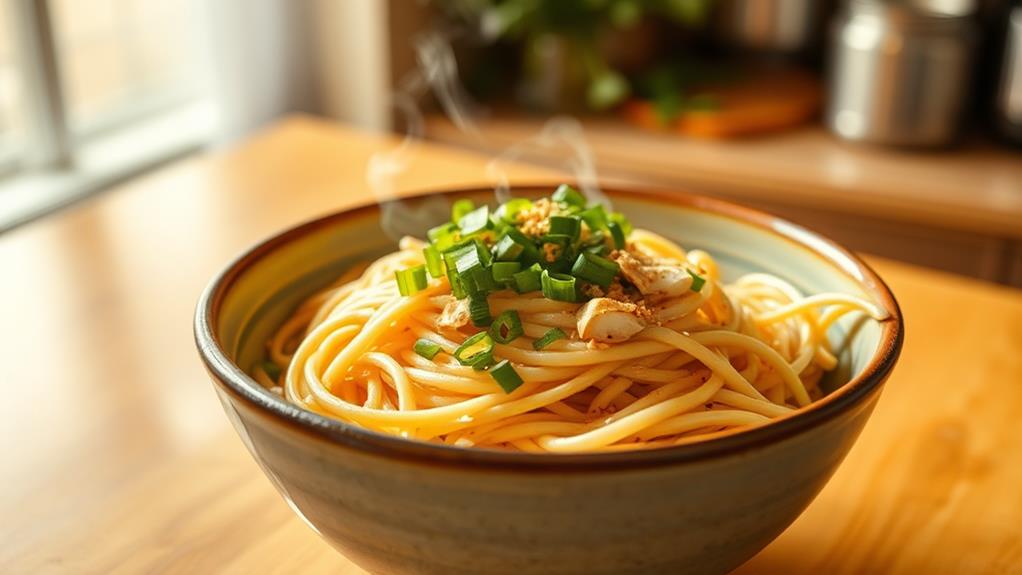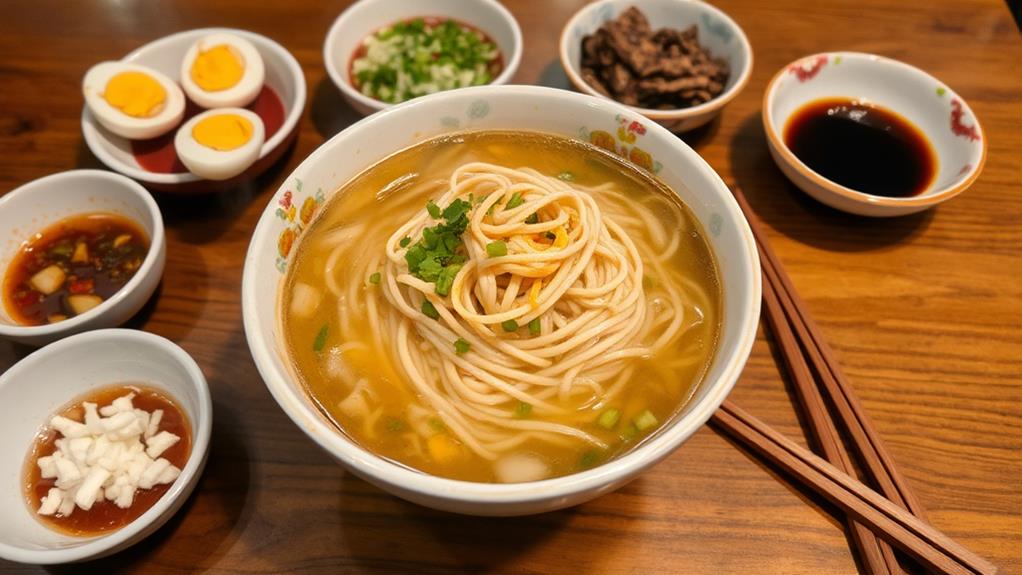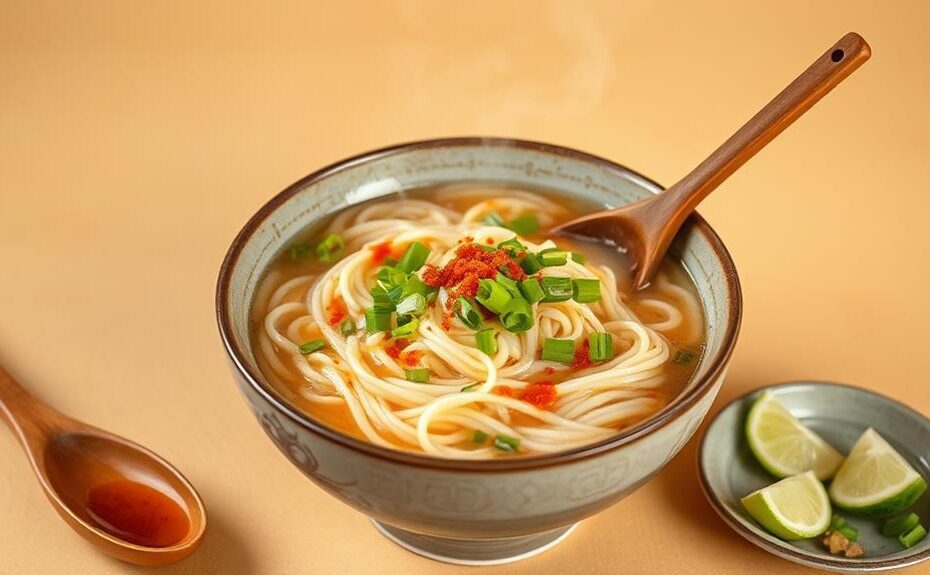Step 1: Prepare Authentic Egg Noodles
To achieve the right texture, cook egg noodles made with lye water.
Blanch them in boiling water for 30 seconds, then rinse and set aside. This step is crucial in creating the perfect Filipino lomi.
Step 2: Create a Rich and Savory Broth
Sauté garlic and onions to create a flavorful base.
Then, brown your choice of protein, such as pork, chicken, or shrimp.
Finally, simmer the broth on low to medium heat for 15 minutes to allow the flavors to meld together.
Step 3: Customize Your Dish
Choose your protein options, such as sliced pork, boiled eggs, or shrimp.
Add fresh seasonal vegetables, like cabbage, carrots, or bell peppers.
Top with crispy elements, such as fried shallots or crushed crackers.
To achieve your desired broth consistency, experiment with cornstarch slurry.
With these customization options, you can make this dish your own.
Mastering Lomi Noodles

Perfectly Cooked Lomi Noodles
To achieve the authentic taste of Pancit Lomi, use thick egg noodles traditionally made with lye water. These noodles provide a delightful chewy texture that complements the rich flavors of the dish.
Preparing Lomi Noodles
To prevent mushiness, blanch lomi noodles in boiling water for about 30 seconds, then rinse and set them aside before adding them to the broth. This step is crucial to maintain their texture and prevent overcooking.
Adding Lomi Noodles to the Broth
Add lomi noodles towards the end of the simmering process to prevent overcooking and maintain their texture. This ensures the noodles absorb the flavors of the broth without becoming mushy.
Fresh vs. Dried Lomi Noodles
Fresh lomi noodles are highly recommended as they absorb the broth better than dried noodles, resulting in a more flavorful and textured dish.
Thickening the Broth
To achieve a thicker broth, add a cornstarch slurry to the soup before incorporating the lomi noodles. This enhances the overall mouthfeel of the dish.
Cooking the Perfect Broth
Crafting the Perfect Broth for Pancit Lomi
To create an authentic Filipino flavor, start by building a flavorful base for the broth. Sauté garlic and onions in oil to achieve this.
Add your choice of protein, such as chicken or pork, and cook until browned. This step is crucial for developing the broth's flavor.
Next, add water and enhance the flavor. Use a Knorr chicken cube or fish sauce to add depth to the broth.
Let it simmer on low to medium heat for about 15 minutes to allow the flavors to meld together. For a richer taste, consider using homemade pork broth as the soup base. This can be prepared in advance and stored for convenience.
To thicken the broth, create a cornstarch-water slurry and gradually stir it into the simmering soup.
Ensure it's mixed well to avoid lumps. Finally, adjust the seasoning with salt, pepper, and soy sauce to taste. Note that the broth will slightly thicken as it cools, so avoid overcooking.
Can I Replicate Filipino Lomi from Restaurants at Home Using Your Simple Steps?
Yes, you can replicate the delicious Filipino lomi from restaurants at home using our simple steps. With the right ingredients and our guidance, you can create a tasty version of this dish in your own kitchen. For now, let’s explore the best filipino lomi restaurants near you for some inspiration.
Customizing Your Lomi Dish

Customize Your Lomi Dish
With a rich and savory broth as your foundation, you can now tailor your Filipino lomi to your taste preferences and dietary needs.
Choose Your Noodles
Start with authentic lomi noodles for a chewy texture. If needed, substitute with other thick noodles.
Add Your Protein
Select your favorite protein: chicken, pork belly, shrimp, or tofu for a vegetarian option.
Add Fresh Vegetables
Experiment with seasonal vegetables like bell peppers, bok choy, or snap peas to add freshness.
Add Texture and Flavor
Top your lomi with crispy lechon kawali, hard-boiled eggs, or fresh scallions for added texture and flavor.
Adjust the Broth
Modify the cornstarch slurry to achieve your desired broth consistency.
Get Creative
Don't be afraid to try new combinations to make your lomi dish unique.
Frequently Asked Questions
Is Lomi Chinese or Filipino?
Lomi is a fusion of Chinese and Filipino cuisines.
Lomi originated from Chinese Lor Mee, but it has undergone significant changes to incorporate local ingredients and flavors in the Philippines, particularly in Batangas.
Today, Filipino Lomi features thick egg noodles, meat, and a rich broth. This adaptation has resulted in regional variations and unique flavors, making Lomi a distinct Filipino dish that blends Chinese and Filipino traditions.
What to Pair With Lomi?
What to Pair with Lomi
When pairing lomi with other dishes, crunchy toppings are a great option.
Try adding lechon kawali or chicharon for a satisfying texture contrast.
For a savory contrast, lumpiang shanghai makes a great accompaniment.
To add a burst of flavor, squeeze a sliver of calamansi or lemon juice over your lomi.
For a filling meal, serve it with a refreshing side salad or steamed rice.
How Do You Preserve Lomi?
Store leftovers in an airtight container in the fridge for up to 3 days to keep lomi fresh. This allows you to enjoy your favorite Filipino dish while retaining its flavor and freshness.
When storing, avoid freezing as it can make the noodles mushy. Instead, reheat only what you'll eat to preserve the texture and taste of the lomi.
If you need to store the noodles and soup separately, use different containers to prevent sogginess.
When reheating, add a splash of water or broth to restore moisture and bring the dish back to life.
Before consuming, always check for signs of spoilage to ensure your safety.
What Is a Substitute for Lomi Noodles?
Fresh egg noodles and thick udon noodles are ideal substitutes for Lomi noodles due to their similar texture. These options work well in Filipino-inspired dishes, providing a comparable base for your recipes.
For gluten-intolerant individuals, rice noodles and buckwheat noodles offer a suitable alternative. These options are gluten-free, making them a great choice for those with dietary restrictions.
Low-carb alternatives include zoodles and shirataki noodles. These options provide a lower-carb substitute for Lomi noodles, ideal for those watching their carb intake.
You can also make your own homemade egg noodles as a customizable base. Simply adjust the cooking time to achieve the perfect texture for your dish.
